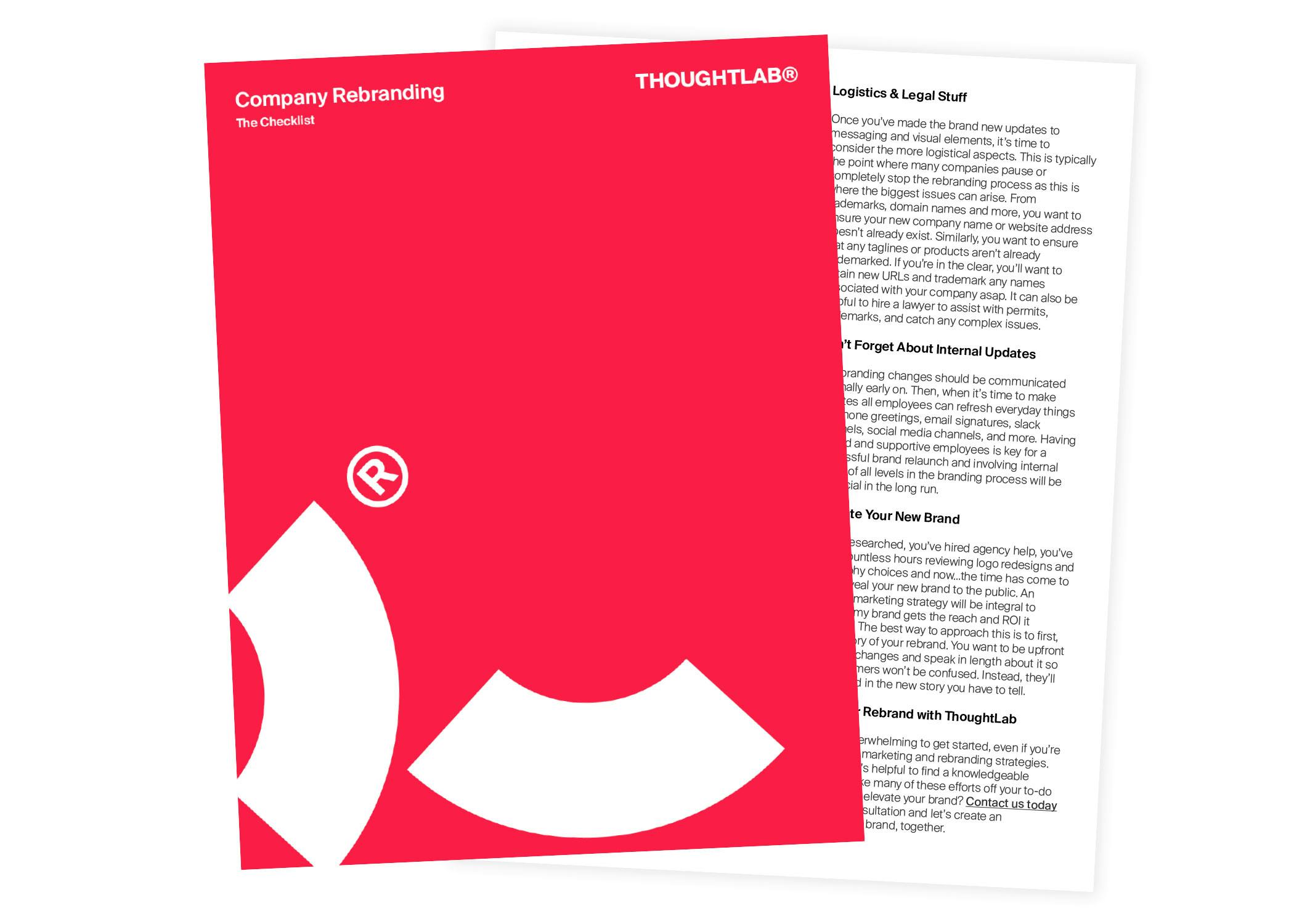
Having a well defined and recognizable brand is paramount to the long term success of any business. Even more so, maintaining customer awareness is crucial to cementing your company in the public consciousness. That’s why rebranding, especially when not done correctly, can be tricky.
Having a well defined and recognizable brand is paramount to the long term success of any business. Even more so, maintaining customer awareness is crucial to cementing your company in the public consciousness. That’s why rebranding, especially when not done correctly, can be tricky.
There are numerous types of rebranding, from a simple font change to a drastic name change, but each update requires a robust rebranding strategy.
In this article we will cover:
- What it means to rebrand your business
- How to know if you need a rebrand
- How to rebrand yourself - the checklist
- Rebranding announcement example
- More resources for your rebrand
In today’s landscape, it can be tempting to rebrand often in order to keep up with the latest trends and grab consumer attention. However, the most important aspect of rebranding is to identify the purpose for a rebrand and lay out a foolproof strategy. Discover our expert rebranding strategy guide and rebranding checklist below and learn the pros and cons of rebranding your business.
What Is Rebranding?
What is rebranding? Well, in order to understand rebranding, we should first understand what it means to have a well defined brand. How do customers relate to your company? What sets your company apart? How do you tell your company's story? A brand encompasses all these aspects. Your brand is your logo and font, yes, but also the language you use, your tone of voice, how you identify with your audience, and so much more.
Rebranding, by this logic, includes any changes you make to the core values of your brand. It can be small or large but regardless, it’s a refresh that requires thought, purpose, and strategy. Often, even a small brand change will likely spill over into other aspects of your company.
Rebranding Your Business: What Does It Mean?
When it comes to rebranding your business, there are several different types of changes you can make to your brand. A partial refresh may include simply tweaking the colors of your logo while a full rebrand will likely touch every aspect of your company top to bottom. Rebranding your business can include the following aspects:
Visual Rebrand
The key visual elements of your branding. These include your logo, color palette, website, social media presence, email signatures, fonts, and more. These elements should be aligned across the board to create a sense of cohesion. So even a simple logo refresh may require you to adjust the appearance of your website.
Company Name
Whether you’re expanding your services, undergoing a merger, or don’t feel that your company name accurately represents your company any longer, a new company name will revamp your brand.
Brand Positioning
Some rebranding efforts may be more internal than external. While you may not need to update your logo or website, you might rethink how customers perceive your brand. Developing new brand personas and re-categorizing your target audience to reach new customers, territories, or industries requires branding strategy.
Voice & Tone
While the language of your brand can change often, your brand’s personality, its key characteristics, its tone and feel, should remain consistent across all written and verbal communications. Your brand’s tone can be refreshed on it’s own but is usually more effective when combined with updated visuals or brand positioning.
Full Rebrand
A total rebrand encompasses all the above, plus, increased PR, social media campaigns, emails, and more to properly promote your new brand.
How Do You Know If You Need to Rebrand?
Rebranding your business shouldn’t be taken lightly. It’s a costly and time consuming process so it’s essential that your entire leadership team is tackling a rebrand with the best of intentions. Just as there are numerous reasons to rebrand your business, and various ways to do it, there are plenty of reasons not to.
Before you begin the process of rebranding your business, ask yourself why. Why are you
rebranding? What is the purpose of rebranding? What do you hope to gain from a rebrand? What/who prompted the rebrand? Uncovering the ‘why’ will help give you clear objectives and set expectations. It also saves you the trouble of having to rebrand again shortly down the road.
There are many reasons why your company might be looking to revamp a logo or elevate the tone of voice, here are a few key indications that your company needs a rebrand:
Change In Services
Brand names can often become synonymous with specific services. If your company has updated its offerings, shifted industries, or expanded into new markets and locations, your current brand may seem irrelevant or outdated. For example, Dunkin’ Donuts rebranded as simply ‘Dunkin’ to make it clear they offer much more than just donuts.
Audience Relationship
If you feel your brand isn’t resonating with your target audience or you want to appeal to a new audience, it might be time for a rebrand. This doesn’t necessarily mean changing everything. A rebrand can be as simple as coining a nickname or as elaborate as wiping the slate clean.
New Business Ventures
This can include anything from expanding your service offerings, entering a new international market, merging/demerging, or a major change in corporate leadership. All of these executive changes will impact how an audience relates to the company and rebranding may be necessary to reestablish yourselves.
Bad PR
Make one (or many) mistakes, even through an association with another company or brand ambassador and you’ll find yourself targeted by the public. A quality rebrand can function like putting your perfectly running engine into a new car. It keeps it running, just with different packaging. Sometimes, a bad reputation doesn’t have anything to do with your actions as a company. For example, the growing body positivity movement led Weight Watchers to rebrand as WW, a wellness company.
It Wasn’t Done Right The First Time
Surprisingly, a huge chunk of company rebrands aren’t related to any of the above factors but rather, that the original design/branding just wasn’t done right the first time. It takes research, care, and expert execution to create a rockstar brand. Sometimes you need to try again and spend more energy crafting a rebranding strategy to ensure it gets done right.
The reasons for rebranding your business will likely fall under one of the above categories. However, sometimes a change in management or desire to compete with others in the industry will lead to unnecessary rebrands. As we’ve discussed, rebrands are expensive and extensive. They require incredible amounts of work and research and therefore, it’s vital you only rebrand when absolutely necessary. When you ask yourself why you’re considering a company rebranding, consider these poor reasons:
Millennials, Gen Z!
Anytime a new brand excels with younger generations, companies across industries sit in a boardroom and ask the question: how can we get that golden gen z crowd to like our product? Rebranding your entire company simply to generate buzz among a younger audience is a slippery slope. Primarily because, there will always be a newer, younger generation. You can’t possibly rebrand yourselves everytime a new target audience comes on the scene. It also may not make sense for your company or industry. Your luxury interior design firm doesn’t need to blow up on TikTok, there’s plenty of other ways to advertise.
(Really) Bad PR
Yes, bad PR was on the list for good reasons to rebrand, however if there’s really bad PR, a rebrand won’t help. In fact, it can do more damage since it can often appear like a band-aid solution. Instead, if there’s a serious public relations crisis it’s better to address the problem head on and seek solutions to remedy the poor publicity before thinking about changing the company name.
New VP
A frequent reason for company rebrands is a change in management. New leaders, especially in the C-suite, come into a company and want to make their mark. By showing that they’re hitting the ground running, they might seek to tinker with the current brand. Unless they were specifically hired for this reason, it’s better to have multiple leaders pushing for change with the research to back it up.
Keeping Up With Competitors
Remember a few years ago when suddenly every brand changed their colors to millennial pink with a big bold font? It already seems dated. That’s because it was merely a trend. Trends are always going to appear, whether it be through colors, fonts, or photography style. You never want to be following trends or rebranding simply because your competitors are. Instead, focus on creating timeless branding that won’t go out of fashion.
How to Rebrand Yourself - The Rebranding Checklist
Creating a comprehensive rebranding strategy requires several steps. From outlining your company’s mission and objectives to getting internal approval to finally promoting your new brand, knowing how to rebrand yourself can be overwhelming. The rebranding process is a lengthy one that should involve high-level strategy, expert research, and tons of collaboration.
This is your new story and you need to ensure it’s told the right way. Not to fear, armed with the right partner and a thoughtful strategy, success is in your future. To help with this process, we’ve created a handy rebranding checklist to start your journey off right.

Rebranding Announcement
When you choose to rebrand your company, a rebranding announcement is a crucial component in getting the word out. There are several channels where you should announce your rebrand. Start by updating all your social pages with your refreshed logo and look. Send newsletters and emails to your customer list explaining the changes. You can also utilize paid ads, your company blog, Instagram stories, and more to spread the world out. Not sure where to start with a rebranding announcement? Take a look at our rebranding announcement template to get started.
Company Rebranding?
Start Your Rebrand with ThoughtLab
Now that you know what’s involved in a company rebrand, you can better determine how you want to approach your own rebranding efforts. Whether you want to tweak your logo, refresh your messaging, or undergo a complete rebrand, these rebrand strategies will give you an excellent place to start.
Of course, it can be overwhelming to get started, even if you’re familiar with marketing and rebranding strategies. That’s why it’s helpful to find a knowledgeable partner to take many of these efforts off your to-do list.
ThoughtLab offers boutique marketing services that range from effective SEO and emotive copywriting to expert paid advertising and engaging web design. Ready to elevate your brand? Contact us today for a free consultation and let’s create an unforgettable brand, together.

